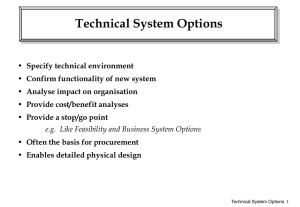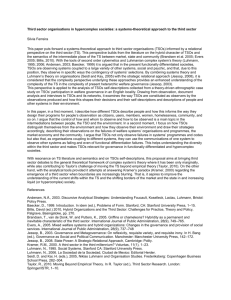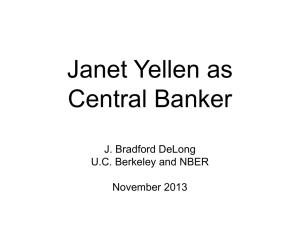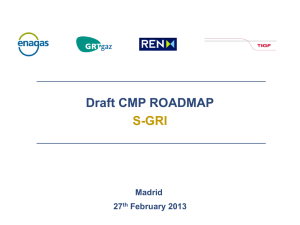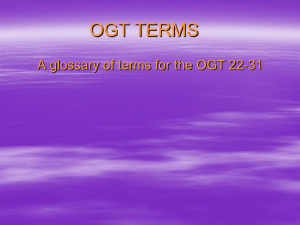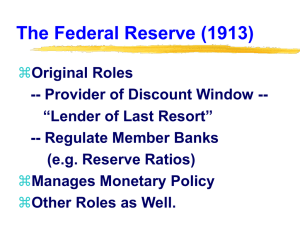Presentation - Northwest Power & Conservation Council
advertisement
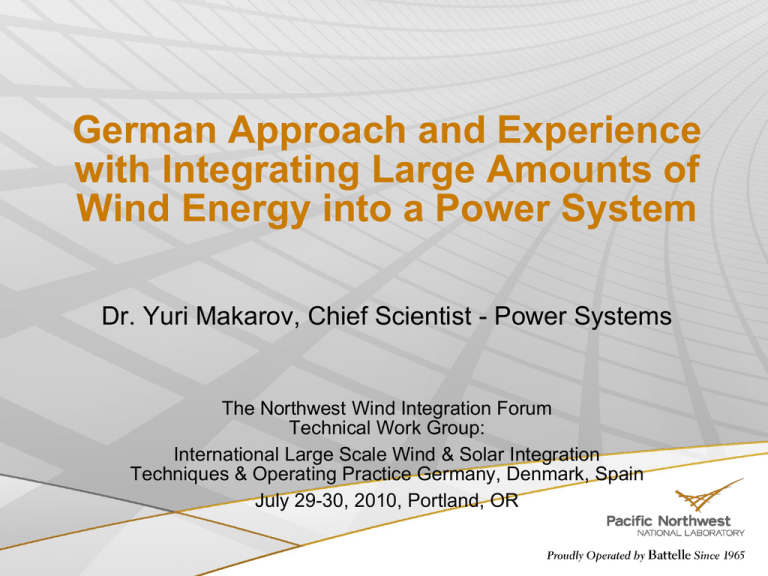
German Approach and Experience with Integrating Large Amounts of Wind Energy into a Power System Dr. Yuri Makarov, Chief Scientist - Power Systems The Northwest Wind Integration Forum Technical Work Group: International Large Scale Wind & Solar Integration Techniques & Operating Practice Germany, Denmark, Spain July 29-30, 2010, Portland, OR Background Information This presentation is based on the report: B. Ernst, U. Schreier, F. Berster, C. Scholz, H.-P. Erbring, S. Schlunke, J.H. Pease, and Y.V. Makarov, “Large-Scale Wind and Solar Integration in Germany,” Final Report PNNL-19225, Pacific Northwest National Laboratory, Richland, WA, February 2010. The report is available online: http://www.pnl.gov/main/publications/external/technical_reports/PNNL19225.pdf The objective is to provide incremental information to the presentation made by Dr. Ing. Hendrik Neumann (Amprion GmbH) Concentration will be made on the 50Hz Transmission GmbH Experience Acknowledgements PNNL’s trips to Spain and Germany were sponsored by BPA Technology Innovation Office Many thanks to Terry Oliver and John Pease, BPA This presentation would not be possible without contributions from Amprion GmbH and 50Hz Transmission GmbH managers and engineers: 50Hz Transmission GmbH: Christian Scholz, Hans-Peter Erbring, Stephan Schlunke Amprion GmbH: Dr. Bernhard Ernst, Uwe Schreier, Frank Berster Outline Facts about the German system Facts about the 50Hz Transmission System Balancing Reserves Structural Factors Helping Wind Integration Operational Factors Helping Wind Integration Structural Factors Causing Problems Operational Factors Causing Problems Changes to Be Made Facts about the German System Facts About the German System: TSOs TSOs are responsible for: Balancing deviations for their portion of renewable resources as well as other deviations Using contracted regulation power for this purpose German TSOs, such as 50HzT, are independent transmission operators which Do not operate the plants Do own transmission system The German Energy Law requires: The TSOs to provide grid access without discrimination Facilitate competition among producers and energy traders. Facts About the German System: Wind Capacity and Ramps Germany has ~ 26 GW of wind capacity and ~10 GW of solar capacity Peak demand is ~ 80 GW Minimum demand is ~ 30 GW One of the largest ramps observed was 5 GW within 8 hours. Wind power during a storm front (Provided by Dr. Bernhard Ernst, Amprion) Facts About the German System: Control Performance Criteria The frequency tolerance in Europe is 200 millihertz. Corresponds to an outage of two nuclear units with the total capacity of 3,000 MW The ACE equation is essentially the same as the one used in the United States: ACE I kf Facts About the 50Hz Transmission System Facts About the 50 Hz Transmission System 50HzT’s load variation is 3,500 MW to 15,000 MW Installed generation capacity is approximately 34,000 MW Pumped storage capacity at 50HzT is 3,100 MW 50HzT has 10,480 MW of installed wind capacity and 300 MW of installed PV capacity Most of the wind and solar power capacity is connected at the distribution level. Balancing Reserves Balancing Reserves Four types of balancing services: Primary Secondary Tertiary Special wind reserve Activation sequence: Balancing reserves activation sequence (Provided by Stephan Schlunke, 50HzT) Balancing Reserves: Primary Reserve Primary regulation (frequency responsive reserve) responds to frequency variations in a continuous automatic manner. All European systems are obligated to provide a total of 3,000 MW of the primary reserve capacity, capable of being deployed in 30 sec The 3,000 MW primary regulation capacity requirement is distributed to each TSO depending on the size of its served load The German share in the European primary reserve is 630 MW The 50HzT share is 135 MW The primary regulation is procured as capacity reserve based on a market mechanism Resources providing primary regulation service are paid for their capacity allocated to this purpose, based on the market price. Balancing Reserves: Secondary Reserve Secondary reserve (regulation) has a 5-minute deployment requirement The German TSOs procure about 4,900 MW (-2,200 MW for the regulation down, and +2,700 MW for the regulation up capacity) Secondary regulation is provided by power plants connected to the automatic generation control (AGC) system. • • These are mainly hydro power plants and pumped hydro plants System operators decide if and when a hydro unit should be started or stopped to provide more or less spinning regulation capacity The secondary regulation resources are paid the market price for both the procured capacity and actual energy provided for regulation. Balancing Reserves: Tertiary Reserves Tertiary reserve (load following) must meet a 15-minute deployment requirement German TSOs procure -2,400 MW of the downward and +2,300 MW of the upward tertiary reserve capacity The tertiary regulation resources are paid the market price for both the procured capacity and actual energy provided. Balancing Reserves: Wind Reserve The German TSOs procure wind reserve. This is not a significant reserve that has a 45-minute deployment characteristic It is activated infrequently. Balancing Reserves: 50Hz-T vs. Amprion Reserve requirements in the Amprion and 50HzT areas TSO Peak load Generation capacity Amprion 29,000 50HzT 15,000 Wind capacity Solar capacity Primary reserve Secondary reserve (regulation) Tertiary reserve (load following) Special wind reserve 47,000 (incl. 4,400 RES) 2,000 270 -875 +1,050 -1,070 +700 +/- 150 34,000 300 135 -464 +532 -532 +288 NA 10,480 Balancing Reserves TSOs pay the market price The energy cost is recovered from the imbalance account, created using payments for deviations from the schedules by responsible energy market participants The capacity payments are recovered from the network utilization charges that are collected from the consumers In the case of wind and solar resources, the TSOs themselves are the responsible parties and are charged for deviations The renewable energy sources are excluded from these deviation charges. These imbalances are paid by the TSOs and remunerated via the EEG scheme. Structural Factors Helping Wind Integration Structural Factors Helping Wind Integration: Distribution of Wind and Solar Resources Higher wind energy potential is observed in the northern and eastern parts of the country The wind generation fleet consists of multiple wind farms This helps to exploit the diversity factor Solar energy potential is higher in southern Germany, but the sunniest locations are on the islands in the Baltic Sea (North-East coast) Solar generation consists of distributed photovoltaic (PV) energy resources. Structural Factor helping Wind Integration: Transmission Network in Germany Strong transmission network in Germany simplifies energy exchanges within the country However, with 26 GW of wind power installed within the German grid, the transmission system is reaching its limit. Operational Factors Helping Wind Integration Operational Factors Helping Wind integration: Energy Market Consists of One Price Area Energy within Germany is bought and sold based on common supply and demand price ladders The market includes the day-ahead market, intraday market, and reserves market The TSOs do not know exact schedules for the next day, the next 15minute dispatch interval or the next hour The schedule can change any time within the operating day as well This is only possible for trades within the same TSO area. Trades across TSO areas must be provided at least 45 minutes ahead. Operational Factors Helping Wind integration: Energy Market Consists of One Price Area TSOs do not apply economic dispatch except for the secondary reserve sharing scheme created by three TSOs The economic dispatch task is addressed by power producers and customers’ suppliers who participate in the market TSOs simply put the schedules together TSOs determine the imbalance cost, congestion cost, etc. The regulator determines the justified costs for balancing wind energy every year and publishes them in a report TSOs profit is tied to how effectively they manage the system imbalances and congestion. Operational Factors Helping Wind integration: Globalization of Wind Power Production Deviations All wind power production and its deviations in Germany are combined virtually (on a 15-minute average basis), and then distributed to each of four transmission system operators (TSOs) The share of wind energy that each TSO has to balance is proportional to consumption or load in each TSO area Not proportional to installed wind power Solar power (PV) is shared only on an energy level (monthly average). Operational Factors Helping Wind Integration: The Forecast Accuracy is Very Good The root mean square (RMS) forecast error is below 4.5% for day-ahead forecasts (all Germany) The TSOs use the services of up to 10 wind forecast service providers They select the best mix of wind energy forecast in real time. Operational Factors Helping Wind Integration: The Forecast Accuracy is Very Good Combining the best forecasts in Europe (Source: Dr. Bernhard Ernst, Amprion, with the plot provided by Energy & Meteo Systems) Operational Factors Helping Wind Integration: The Forecast Accuracy is Very Good Day ahead forecast Germany 20.000 Prog1 Prog2 Prog3 Combined Forecast Measurement [ MW ] 18.000 16.000 14.000 12.000 10.000 8.000 6.000 4.000 2.000 0 KW 47 from 17 to 23 November 2008 50HzT wind power forecasts (Provided by Christian Scholz, 50HzT) Operational Factors Helping Wind Integration: German TSOs Use 15-minute Scheduling Intervals Within the Country Schedules within the country can change any time 15-minute schedules are possible within a control area Exchanges with the other control areas are scheduled based on 1-hour intervals Bilateral trades can be 15-minute based. Operational Factors Helping Wind Integration: Wind Production Curtailments are Possible in Case of Jeopardized “Security of Supply” These events are rare in the transmission system, but happen frequently in the distribution networks. Operational Factors Helping Wind Integration: Security Cooperation (TSC) in Central Europe TSO Security Cooperation (TSC) in Central Europe includes 12 TSOs TSC facilitates cooperation and coordination between TSOs in the form of: Common TSO data exchange TSO security panel of experts Cross-border redispatch Wide-area arrangements to handle transmission congestion Operational Factors Helping Wind Integration: Security Cooperation (TSC) in Central Europe Wide area security region is implemented in Europe* between several TSOs to manage congestion problem (Central Allocation Office GmbH) Source: David Myska, “Allocation Algorithm Review”, 2nd Workshop for Market Participants, Central Allocation Office GmbH, Munich, August 12, 2009. Operational Factors Helping Wind Integration: European Network of Transmission System Operators for Electricity (ENTSO-E) ENTSO-E integrates 42 TSOs from 34 countries European Network of Transmission System Operators for Electricity (ENTSO-E) pursues the following main tasks: Establishing and elaborating on network codes Coordinating network operation by common network operation tools Developing a 10-year network development plan Publishing an annual work program, annual report and annual summer and winter generation adequacy outlooks ENTSO-E objectives include: Ensure security of supply Meet the needs of the energy market and facilitate market integration Promote R&D and public acceptance of transmission infrastructure Consult with stakeholders on energy policy issues. Operational Factors Helping Wind Integration: Imbalance Sharing Scheme Similar to the ACE Diversity Interchange (ADI) Program. Three German TSOs (excluding Amprion) implemented an imbalance sharing scheme that is similar to the area control error (ACE) diversity interchange (ADI) program in the United States, and operates in real time. Operational Factors Helping Wind Integration: Imbalance Sharing Scheme Similar to the ACE Diversity Interchange (ADI) Program. Shared secondary reserve utilization scheme (Provided by Stephan Schlunke, 50HzT) Step/module Innovation Module 1: Since 17.12.2008: Compensation of imbalances in opposite direction in joint control areas Module 2: Since 05.05.2009: Mutual support in case of insufficient secondary power in one or more control areas Conclusion: Reduction of secondary power reservation in the joint control areas; Introduction of an equal price for regulation energy within the joint control areas that has to be paid by traders organized in balance groups Module 3: Since 01.07.2009: Realization Realisation of the principle that reserve providers reserve resources get the request for activation only from the connecting TSO; A Every resource object can be activated for the entire jont control area by the optimization tool Module 4: Since 01.09.2009: Activation of secondary reserve is exclusively made by the optimization tool using the mutual merit order list for SR (MOL). Module 5: … Operational Factors Helping Wind Integration: Imbalance Sharing Scheme Similar to the ACE Diversity Interchange (ADI) Program. Primary and secondary reserve capacity reduction caused by secondary reserve utilization scheme (Provided by Stephan Schlunke, 50HzT) Kind of control reserve Primary power reserve Secondary power reserve Tertiary power reserve Reserved for VE Transmission before module 2 was started / now ± 135 MW ± 135 MW + 630 MW / - 450 MW + 532 MW / - 464 MW + 350 MW / -756 MW + 288 MW / - 532 MW Structural Factors Causing Problems Structural Factors Causing Problems: Excessive Generation Capacity Excessive generation capacity in some control areas (e.g., in the 50HzT area) creates problems with selling wind energy for these TSOs 50HzT experienced over-generation situations four times in 2008, and three times in 2009 (with wind power production exceeding 7,200 – 8,200 MW) The problem will be aggravated with 18,000 MW of wind capacity expected in 2017 in the control area of 50HzT, while the system load remains the same or decreases. Structural Factors Causing Problems: The Continuing Increase of Wind and Solar Energy in Germany The continuing increase of wind and solar energy in Germany, with more offshore wind energy additions, creates new operational problems In the 50HzT area, about 18,000 MW of wind power capacity is expected (with 10,480 MW connected at the moment 14 new offshore wind farms are in the queue, with a total capacity of 3,600 MW (first stage). Structural Factors Causing Problems: The Continuing Increase of Wind and Solar Energy in Germany Arkona-ArkonaSee Ost Arkona- See Ventotec Ost 2 Arcadis See Süd Adlergrund West Ost 1 Gap* Adlergrund 500 ArkonaBecken Südost Kriegers Flak 1 DK Baltic 1 Fehmarn Beltsee Rügen Fairwind Beta Baltic SchleswigHolstein Lüdershagen Bentwisch Usedom Lubmin PL MecklenburgVorpommern Hamburg * Alternatively Arcadis Ost 2 Total: ~ 3.600 MW (First stage) Near-term offshore wind capacity additions in the 50HzT (Provided by H.-P. Erbring, 50HzT) Structural Factors Causing Problems: No Restrictions on Integrating More Wind Into the German System There is no restriction on integrating more wind into the German system except for the limits regulating the distance from wind farms to households Nevertheless, there are restrictions and rules imposed by local authorities Obtaining permission for a wind farm is a long process and not always successful. Structural Factors Causing Problems: No Direct Control Over Wind Generation Connected at the Distribution Level There is no direct control over wind generation connected at the distribution level because of the current lack of technical connectivity between the wind farms and the control centers. Operational Factors Causing Problems Operational Factors Causing Problems: Wind and Solar Power Plants Produce “Must Take” Energy Wind and solar power plants produce “must take” energy Except when wind power production is curtailed because of the system security conditions. Operational Factors Causing Problems: Congestion Within Germany, there is no “official” congestion Nevertheless, congestion can occur during high wind periods The NE-SW flows are a pressing and ever increasing problem Currently, 50HzT has to utilize remedial actions on approximately 150 days a year. Because of the loop flows, congestion on the GermanPolish border is a problem Overloads on transformers connecting the 50HzT area with Poland have been observed. Operational Factors Causing Problems: Congestion Congestion problems on Germany's tie lines (Provided by Bernhard Ernst, Amprion) Operational Factors Causing Problems: Loop Flows Loop flows that are created by wind energy go through another country’s transmission systems, such as Poland and the Czech Republic France and the Netherlands have installed phase shifting transformers to defend against the loop flows through their systems. Operational Factors Causing Problems: Loop Flows Example of loop flows (Provided by Bernhard Ernst, Amprion) Operational Factors Causing Problems: Negative Prices Negative prices occur infrequently and can reach -500 euro/MWh. Minus 3,000 euro/MWh is the limit of the Energy Exchange. Energy prices in Germany (October 2008 - May 2009, Provided by Dr. Bernhard Ernst, Amprion) Operational Factors Causing Problems: The Wind Forecasting System is not Comprehensive Does not include all wind farms Based on up-scaling of the forecasts provided for about 130 locations in the country Approach includes: Up-scaling of wind generation for each square area of 10 x 10 km; and Aggregation of all square areas. The algorithm results in a weighted sum of all online measurements. Operational Factors Causing Problems: The Wind Forecasting System is not Comprehensive: Up-scaling tool’s user interface (Provided by Christian Scholz, 50HzT) Operational Factors Causing Problems: The Wind Forecasting System is not Comprehensive The accuracy of the up-scaling process (Provided by Christian Scholz, 50HzT) Power Overestimation -799 MW Underestimation 988 MW Average (bias) 0 MW Standard deviation 146 MW RMSE 1,58 % * Deficit 450 GWh Surplus 451 GWhcapacity) ( * of installed Energy Total 1 GWh Operational Factors Causing Problems: Very Large Forecast Errors are Rare, but Occur Once or Twice a Year Einspeisung Power in MW 7.000 2.000 Hochrechnung Upscaling Zählwerte Metering Fehler Error 1.500 6.000 1.000 5.000 500 4.000 0 3.000 -500 2.000 -1.000 1.000 -1.500 Fehler Error in MW 8.000 0 -2.000 Up-scaling error for wind generation (Provided by Christian Scholz, 50HzT) KW 3 von 15. bis 21. Januar 2007 Changes to Be Made in the German System Transition from the bilateral market to a power exchange market structure has been made Accommodation of additional amounts of wind capacity will be impossible without major transmission system enhancements. Bigger systems, super grids, interconnecting the European system with the Russian system are potential solutions to future problems Looking for new technologies for energy storage and smart grids. Changes to Be Made in the German System Measures need to be developed to handle loop flows, including coordinated solutions, multilateral remedial actions and solutions for cost sharing and cost recovery To address problems with maintaining system inertia, mitigation measures are currently under development. They include assigning must-run units and providing ancillary services from them. Conclusions (1) The German experience with operating a system with 26,000 MW of wind power capacity may be of interest to the BPA and the other balancing authorities Solutions found by the Wind Integration Team are consistent with the best international experience: Sub-hourly scheduling process ACE sharing (ACE diversity interchange) scheme Incorporating wind energy and wind power ramps forecasts into the BPA operations Creating sub-hour balancing mechanisms and markets Conclusions (2) At the same time, the German experience helps to see more clearly problems that BPA might face in the future: Loop flows and additional congestion created by wind power production outside of its native area Over-generation Infrequent, very significant imbalances caused by large forecast errors (“tail events”) Possible problems with low system inertia An evaluation of these potential problems could help BPA to be better prepared to face them, as well as to find solutions ahead of time. Conclusions (3) Some approaches undertaken in Germany could be of interest for BPA as improvements or even potential new solutions. They include: Experience with accurate forecasting of wind power production The use of multiple forecast services from different providers The use of weighted sums of the forecasts with adjustable weights The idea of globalizing wind power production and deviations among multiple TSOs Imbalance sharing scheme (similar to the ADI) employs an idea of sharing regulating resources so that a particular resource can be selected to provide regulation service for any of the participating TSOs based on merit order, without considering its actual location Experience with establishing a common frequency response reserve standard and sharing the reserve obligation among the Balancing Authorities deserves more attention.
